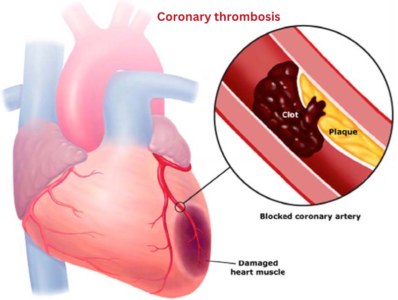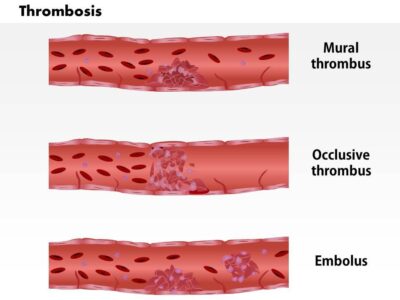Unmasking Coronary Thrombosis: Causes, Symptoms, and Prevention

Coronary thrombosis, often referred to as a heart attack, is a serious medical condition that affects millions of people around the world. While it may be a familiar term, understanding the intricacies of coronary thrombosis is crucial for prevention and early intervention. In this comprehensive guide, we’ll explore the causes, symptoms, and prevention strategies for coronary thrombosis.
What is Coronary Thrombosis?
Coronary thrombosis, more commonly known as a heart attack, occurs when the blood supply to the heart muscle is suddenly blocked. This blockage is often caused by a blood clot or atherosclerosis, the buildup of fatty deposits (plaques) in the coronary arteries. When blood flow is obstructed, the heart muscle is deprived of oxygen, leading to tissue damage and potentially life-threatening consequences.
Causes of Coronary Thrombosis
Coronary thrombosis has several underlying causes, including:
Atherosclerosis: This condition, characterized by the narrowing and hardening of the coronary arteries due to plaque buildup, is a primary cause of heart attacks.
Blood Clots: A clot can form inside a narrowed artery, completely blocking blood flow.
Spasms: Occasionally, the coronary arteries can constrict, reducing blood flow. In some cases, spasms can trigger a heart attack.
Inflammation: Inflammatory conditions, such as vasculitis or lupus, can contribute to coronary thrombosis.
Risk Factors: Certain risk factors, including smoking, high blood pressure, high cholesterol, obesity, and diabetes, increase the likelihood of heart attacks.
Symptoms and Warning Signs
Recognizing the symptoms of coronary thrombosis is crucial for seeking immediate medical attention. Common symptoms include:
Chest Pain: Typically described as a crushing, squeezing, or burning sensation in the chest.
Radiating Pain: Pain may spread to the arms, neck, jaw, or back.
Shortness of Breath: Often accompanies chest pain.
Sweating: Profuse sweating, even in cool conditions.
Nausea and Vomiting: Some individuals experience nausea and may vomit.
Dizziness and Fainting: A feeling of lightheadedness or fainting can occur.
Remember, symptoms can vary between individuals, and some may experience atypical or subtle signs. If you suspect a heart attack, call emergency services immediately.
The Role of Lifestyle in Coronary Thrombosis
Lifestyle choices play a significant role in the development of coronary thrombosis. Here’s how various factors contribute:
Diet: A diet high in saturated and trans fats, cholesterol, and salt increases the risk of atherosclerosis. Opt for a heart-healthy diet rich in fruits, vegetables, whole grains, and lean proteins.
Smoking: Smoking damages blood vessels, accelerates atherosclerosis, and increases the risk of blood clots. Quitting smoking is one of the best things you can do for your heart health.
Physical Activity: A sedentary lifestyle contributes to obesity and poor cardiovascular health. Regular exercise helps maintain a healthy weight and promotes heart health.
Stress: Chronic stress can raise blood pressure and contribute to heart problems. Effective stress management techniques, such as meditation or yoga, can be beneficial.
Alcohol Consumption: Excessive alcohol consumption can lead to high blood pressure and increase the risk of heart attack. Drink in moderation or consider abstaining altogether.
Preventing Coronary Thrombosis
Preventing coronary thrombosis requires a proactive approach to heart health. Here are some strategies to reduce your risk:
Healthy Diet: Embrace a diet rich in fruits, vegetables, whole grains, lean proteins, and healthy fats.
Regular Exercise: Aim for at least 150 minutes of moderate-intensity exercise per week.
Quit Smoking: Seek support and resources to quit smoking if you are a smoker.
Manage Stress: Find stress-reduction techniques that work for you, such as meditation, deep breathing, or hobbies.
Regular Check-ups: Visit your healthcare provider for regular check-ups, blood pressure monitoring, and cholesterol screenings.
Medication: If you have risk factors or a history of heart disease, your doctor may prescribe medications to help manage your condition.
Aspirin: In some cases, aspirin may be recommended to reduce the risk of blood clots. Consult your doctor before starting any medication.
Coronary thrombosis is a severe and potentially life-threatening condition. Understanding its causes, recognizing its symptoms, and adopting a heart-healthy lifestyle can significantly reduce the risk of heart attacks. By taking control of your health and making informed choices, you can protect your heart and enjoy a longer, healthier life. Remember, if you ever experience symptoms of a heart attack, don’t hesitate—call for emergency help immediately. Your life may depend on it.



